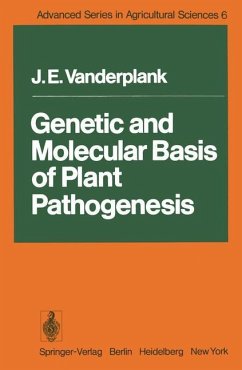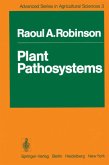J. E. Vanderplank
Genetic and Molecular Basis of Plant Pathogenesis
J. E. Vanderplank
Genetic and Molecular Basis of Plant Pathogenesis
- Broschiertes Buch
- Merkliste
- Auf die Merkliste
- Bewerten Bewerten
- Teilen
- Produkt teilen
- Produkterinnerung
- Produkterinnerung
As befits a volume in the Advanced Series in Agricultural Sciences, this book was written with problems of practical agriculture in mind. One of the ways of controlling plant disease is by using resistant cultivars; and from the wide literature of genetics and biochemistry in plant pathology I have emphasized what seems to bear most closely on breeding for disease resistance. This has a double advantage, for it happens all to the good that this emphasis is also an emphasis on primary causes of disease, as distinct from subsequent processes of symptom expression and other secondary effects. The…mehr
Andere Kunden interessierten sich auch für
![Plant Pathogenesis Plant Pathogenesis]() Harry WheelerPlant Pathogenesis83,99 €
Harry WheelerPlant Pathogenesis83,99 €![Plant Molecular Biology ¿ A Laboratory Manual Plant Molecular Biology ¿ A Laboratory Manual]() Plant Molecular Biology ¿ A Laboratory Manual81,99 €
Plant Molecular Biology ¿ A Laboratory Manual81,99 €![Viral Genes and Plant Pathogenesis Viral Genes and Plant Pathogenesis]() Viral Genes and Plant Pathogenesis81,99 €
Viral Genes and Plant Pathogenesis81,99 €![Plant Pathosystems Plant Pathosystems]() Raoul A. RobinsonPlant Pathosystems83,99 €
Raoul A. RobinsonPlant Pathosystems83,99 €![Cyanidioschyzon merolae Cyanidioschyzon merolae]() Cyanidioschyzon merolae161,99 €
Cyanidioschyzon merolae161,99 €![Pigments in Fruits and Vegetables Pigments in Fruits and Vegetables]() Pigments in Fruits and Vegetables121,99 €
Pigments in Fruits and Vegetables121,99 €![Plant Molecular Biology Plant Molecular Biology]() Donald GriersonPlant Molecular Biology42,99 €
Donald GriersonPlant Molecular Biology42,99 €-
-
-
As befits a volume in the Advanced Series in Agricultural Sciences, this book was written with problems of practical agriculture in mind. One of the ways of controlling plant disease is by using resistant cultivars; and from the wide literature of genetics and biochemistry in plant pathology I have emphasized what seems to bear most closely on breeding for disease resistance. This has a double advantage, for it happens all to the good that this emphasis is also an emphasis on primary causes of disease, as distinct from subsequent processes of symptom expression and other secondary effects. The chapters are entirely modern in outlook. The great revolution in biology this century had its high moments in the elucidation of the DNA double helix in 1953 and the deciphering of the genetic code in 1961. This book, so far as I know, is the first in plant pathology to be conceived within the framework of this new biology. Half the book could not have been written 20 years ago, even if there had then been available all the literature that has since accumulated on the genetics and chemistry of plant disease. The new biology is the cement this book uses to bind the literature together. Another feature of this book is an emphasis on thermodynamics.
Hinweis: Dieser Artikel kann nur an eine deutsche Lieferadresse ausgeliefert werden.
Hinweis: Dieser Artikel kann nur an eine deutsche Lieferadresse ausgeliefert werden.
Produktdetails
- Produktdetails
- Advanced Series in Agricultural Sciences .6
- Verlag: Springer / Springer Berlin Heidelberg / Springer, Berlin
- Artikelnr. des Verlages: 978-3-642-66967-5
- Softcover reprint of the original 1st ed. 1978
- Seitenzahl: 188
- Erscheinungstermin: 16. Dezember 2011
- Englisch
- Abmessung: 244mm x 170mm x 11mm
- Gewicht: 334g
- ISBN-13: 9783642669675
- ISBN-10: 3642669670
- Artikelnr.: 36114930
- Herstellerkennzeichnung Die Herstellerinformationen sind derzeit nicht verfügbar.
- Advanced Series in Agricultural Sciences .6
- Verlag: Springer / Springer Berlin Heidelberg / Springer, Berlin
- Artikelnr. des Verlages: 978-3-642-66967-5
- Softcover reprint of the original 1st ed. 1978
- Seitenzahl: 188
- Erscheinungstermin: 16. Dezember 2011
- Englisch
- Abmessung: 244mm x 170mm x 11mm
- Gewicht: 334g
- ISBN-13: 9783642669675
- ISBN-10: 3642669670
- Artikelnr.: 36114930
- Herstellerkennzeichnung Die Herstellerinformationen sind derzeit nicht verfügbar.
1 Variation in the Resistance of the Host and in the Pathogenicity of the Parasite.- 1.1 Introduction.- 1.2 Systems of Variation.- 1.3 Vertical Resistance with Host-Pathogen Specificity.- 1.4 Vertical Resistance Without Host-Pathogen Specificity.- 1.5 Epidemiological Consequence of Nonspecific Vertical Resistance.- 1.6 Vertical Resistance Without Hypersensitivity.- 1.7 Correlated Variation in Host and Pathogen.- 1.8 Uncorrelated Variation in Horizontal Resistance.- 1.9 Absence of a Host-Pathogen Differential Interaction in Horizontal Resistance.- 1.10 Uniform Ranking Order in Horizontal Resistance.- 1.11 Tests for Vertical and Horizontal Resistance.- 2 The Gene-for-Gene and the Protein-for-Protein Hypotheses.- 2.1 Introduction.- 2.2 Why Proteins? Why Polymerization?.- 2.3 Flor's Gene-for-Gene Hypothesis.- 2.4 The Living Host Cell Nucleus in Compatible Gene-for-Gene Combinations.- 2.5 The Gene for Susceptibility and Its Different Roles.- 2.6 Comments Arising from the Possibility of Tandem Duplication.- 2.7 The Gene for Avirulence and Its Different Roles.- 2.8 Susceptibility and Resistance. Neutral Mutation.- 2.9 Avirulence and Virulence.- 2.10 Isozymes.- 2.11 The Hydrophobic Effect. Amino Acids with Hydrophobic Side Chains. Their Interrelated Genetic Codes.- 2.12 Amino Acids with Hydrophilic Side Chains. Their Part in Catalysis.- 2.13 Protein Structures.- 2.14 Protein-Protein Recognition.- 3 The Protein-for-Protein Hypothesis: Temperature Effects and Other Matters.- 3.1 Introduction.- 3.2 The Thermodynamic Problem.- 3.3 Inactivation of Protein Monomers.- 3.4 Effect of Temperature on Resistance to Wheat and Oat Stem Rust and Oat Crown Rust.- 3.5 Temperature and Infection of Tomato Plants by Tobacco Mosaic Virus.- 3.6 The Temperature Effect in Some Other Diseases.- 3.7Some Seemingly Anomolous Examples Considered.- 3.8 Temperature Reversal.- 3.9 Conditional Responses to Temperature. Dominance of Resistance as a Test.- 3.10 Protein Polymerization and the Solvent.- 3.11 Osmotic Pressure Differences.- 3.12 Analytical Difficulties Arising from Procedures.- 3.13 Isozymes and Electrophoresis.- 3.14 A Hypothesis About Susceptibility and Resistance.- 3.15 Feeding the Pathogen. Function of Genes for Avirulence.- 3.16 In Fungus Disease, is Wound Protein the Host Protein Involved? The Function of Genes for Susceptibility.- 3.17 Autoregulation of Gene Expression.- 3.18 A Corollary.- 3.19 Comparison with Antigen-Antibody Systems.- 3.20 Peroxidase Production in Infected Susceptible Plants.- 3.21 The Lag Phase in the Resistance Reaction.- 3.22 Uniformity in Resistance Reaction Types. Secondary Effects.- 3.23 Temperature Limits Again. The Genes Sr6 and Sr 11. Effect of Ethylene.- 3.24 In Virus Disease, Is RNA Replicase the Protein Involved?.- 3.25 Summary and Conclusions.- 3.26 Identifying Gene-for-Gene Disease.- 4 Common Antigenic Surfaces in Host and Pathogen.- 4.1 Introduction.- 4.2 Common Antigens in the Flax-Flax Rust System and Some Other Systems.- 4.3 Coexistence of Complementary and Similar Surfaces.- 4.4 The Intrinsic Experimental Difficulty.- 4.5 Alternative Hypotheses About Common Antigens.- 4.6 Common Antigenic Determinants in Other Than Gene-for-Gene Systems.- 4.7 Common Antigens and Male-Female Recognition in Plants.- 5 Other Large Molecules in Relation to Gene-for-Gene Disease.- 5.1 Introduction.- 5.2 DNA.- 5.3 RNA.- 5.4 Glycoproteins.- 5.4.1 The Nature of Glycoproteins.- 5.4.2 Membranes and Membrane Glycoproteins.- 5.4.3 The Carbohydrate Determinants of the AB0 Blood Cell Types.- 5.4.4 One Gene-One Glycosidic Linkage Hypothesis.- 5.4.5 Glycoproteins and the Elicitor Hypothesis.- 5.4.6 An Active Glycoprotein from Phytophthora megasperma var. sojae.- 5.4.7 A Thermodynamic Objection.- 5.4.8 Elicitors Are Unspecific.- 5.5 Polysaccharides.- 5.6 Lectins.- 5.7 Phytoalexins.- 6 Population Genetics of the Pathogen.- 6.1 Introduction.- 6.2 Directional Selection Towards Virulence.- 6.3 Stabilizing Selection Against Virulence.- 6.4 Nonallelic Virulence Interaction in Stabilizing Selection.- 6.5 The Environmental Effect in Nonallelic Interaction Between Virulence on Genes Sr6 and Sr9d.- 6.6 Dissociation of Virulence Through Repulsion.- 6.7 Association of Virulence as an Indirect Consequence of Repulsion.- 6.8 Evidence for Nonallelic Virulence Interactions in Some Other Diseases.- 6.9 A Hypothesis About the Nonallelic Virulence Interaction.- 6.10 The Second Gene-for-Gene Hypothesis.- 6.11 The Commonness of Weak Resistance Genes.- 6.12 The Use of Weak Resistance Genes.- 6.13 The Gap in the Use of Vertical Resistance in Plant Breeding.- 6.14 A Guide to the Use of Vertical Resistance.- 6.15 How to Improve the Performance of Vertical Resistance.- 6.16 The Durability of Vertical Resistance.- 6.17 The Effect of Vertical Resistance on Epidemics.- 7 Horizontal Resistance to Disease.- 7.1 Introduction.- 7.2 Horizontal Resistance Not Disguised Vertical Resistance.- 7.2.1 Hypothesis That Horizontal Resistance Is Buried Vertical Resistance.- 7.2.2 Hypothesis That Horizontal Resistance Is Massed Vertical Resistance.- 7.3 Examples of the Rapid Accumulation of Horizontal Resistance.- 7.4 Polygenic Inheritance.- 7.4.1 Confusion About Polygenes.- 7.4.2 Discontinuous Variation and Qualitative Characters; Continuous Variation and Quantitative Characters.- 7.4.3 Polygenic Variation.- 7.4.4 The Untrue Converse.- 7.5 The Number of Genes Conditioning Horizontal Resistance.- 7.6 The Anonymity of Horizontal Resistance Genes.- 7.7 Specificity in Horizontal Resistance.- 7.8 The Vertifolia Effect.- 7.9 Resistance and Loss of Fitness.- 7.10 Epidemiological Effects of Horizontal Resistance.- 7.10.1 Effect on the Infection Rate.- 7.10.2 Delay of the Start of an Epidemic.- 7.10.3 Contraction of the Scale of Spread of an Epidemic.- 8 Selective Pathotoxins in Host-Pathogen Specificity.- 8.1 Introduction.- 8.2 Some Diseases Caused by Selective Pathotoxins.- 8.2.1 Victoria Blight of Oats.- 8.2.2 Southern Maize Leaf Blight.- 8.2.3 Eye Spot Disease of Sugarcane.- 8.3 Selective Pathotoxins Unconnected with Gene-for-Gene Systems.- 8.4 Evidence for Horizontal Resistance.- 8.5 Horizontal Resistance with a Threshold.- 9 A Molecular Hypothesis of Vertical and Horizontal Resistance.- 9.1 The Hypothesis.- 9.2 Catalysis the Transformer and Eroder of Qualitative Variation.- 9.3 Vertical Resistance: Qualitative Variation.- 9.4 Horizontal Resistance: Quantitative Variation.- 9.5 Vertical Resistance: Reciprocal Host-Pathogen Variation in the Same Class.- 9.6 Horizontal Resistance: Host-Pathogen Variation of Different Kinds.- 10 Biotrophy, Necrotrophy, and the Lineage of Symbiosis.- 10.1 Introduction.- 10.2 Necrotrophy, Biotrophy, and Biotrophy-Necrotrophy Sequences.- 10.3 The Lineage of Symbiosis.- References.
1 Variation in the Resistance of the Host and in the Pathogenicity of the Parasite.- 1.1 Introduction.- 1.2 Systems of Variation.- 1.3 Vertical Resistance with Host-Pathogen Specificity.- 1.4 Vertical Resistance Without Host-Pathogen Specificity.- 1.5 Epidemiological Consequence of Nonspecific Vertical Resistance.- 1.6 Vertical Resistance Without Hypersensitivity.- 1.7 Correlated Variation in Host and Pathogen.- 1.8 Uncorrelated Variation in Horizontal Resistance.- 1.9 Absence of a Host-Pathogen Differential Interaction in Horizontal Resistance.- 1.10 Uniform Ranking Order in Horizontal Resistance.- 1.11 Tests for Vertical and Horizontal Resistance.- 2 The Gene-for-Gene and the Protein-for-Protein Hypotheses.- 2.1 Introduction.- 2.2 Why Proteins? Why Polymerization?.- 2.3 Flor's Gene-for-Gene Hypothesis.- 2.4 The Living Host Cell Nucleus in Compatible Gene-for-Gene Combinations.- 2.5 The Gene for Susceptibility and Its Different Roles.- 2.6 Comments Arising from the Possibility of Tandem Duplication.- 2.7 The Gene for Avirulence and Its Different Roles.- 2.8 Susceptibility and Resistance. Neutral Mutation.- 2.9 Avirulence and Virulence.- 2.10 Isozymes.- 2.11 The Hydrophobic Effect. Amino Acids with Hydrophobic Side Chains. Their Interrelated Genetic Codes.- 2.12 Amino Acids with Hydrophilic Side Chains. Their Part in Catalysis.- 2.13 Protein Structures.- 2.14 Protein-Protein Recognition.- 3 The Protein-for-Protein Hypothesis: Temperature Effects and Other Matters.- 3.1 Introduction.- 3.2 The Thermodynamic Problem.- 3.3 Inactivation of Protein Monomers.- 3.4 Effect of Temperature on Resistance to Wheat and Oat Stem Rust and Oat Crown Rust.- 3.5 Temperature and Infection of Tomato Plants by Tobacco Mosaic Virus.- 3.6 The Temperature Effect in Some Other Diseases.- 3.7Some Seemingly Anomolous Examples Considered.- 3.8 Temperature Reversal.- 3.9 Conditional Responses to Temperature. Dominance of Resistance as a Test.- 3.10 Protein Polymerization and the Solvent.- 3.11 Osmotic Pressure Differences.- 3.12 Analytical Difficulties Arising from Procedures.- 3.13 Isozymes and Electrophoresis.- 3.14 A Hypothesis About Susceptibility and Resistance.- 3.15 Feeding the Pathogen. Function of Genes for Avirulence.- 3.16 In Fungus Disease, is Wound Protein the Host Protein Involved? The Function of Genes for Susceptibility.- 3.17 Autoregulation of Gene Expression.- 3.18 A Corollary.- 3.19 Comparison with Antigen-Antibody Systems.- 3.20 Peroxidase Production in Infected Susceptible Plants.- 3.21 The Lag Phase in the Resistance Reaction.- 3.22 Uniformity in Resistance Reaction Types. Secondary Effects.- 3.23 Temperature Limits Again. The Genes Sr6 and Sr 11. Effect of Ethylene.- 3.24 In Virus Disease, Is RNA Replicase the Protein Involved?.- 3.25 Summary and Conclusions.- 3.26 Identifying Gene-for-Gene Disease.- 4 Common Antigenic Surfaces in Host and Pathogen.- 4.1 Introduction.- 4.2 Common Antigens in the Flax-Flax Rust System and Some Other Systems.- 4.3 Coexistence of Complementary and Similar Surfaces.- 4.4 The Intrinsic Experimental Difficulty.- 4.5 Alternative Hypotheses About Common Antigens.- 4.6 Common Antigenic Determinants in Other Than Gene-for-Gene Systems.- 4.7 Common Antigens and Male-Female Recognition in Plants.- 5 Other Large Molecules in Relation to Gene-for-Gene Disease.- 5.1 Introduction.- 5.2 DNA.- 5.3 RNA.- 5.4 Glycoproteins.- 5.4.1 The Nature of Glycoproteins.- 5.4.2 Membranes and Membrane Glycoproteins.- 5.4.3 The Carbohydrate Determinants of the AB0 Blood Cell Types.- 5.4.4 One Gene-One Glycosidic Linkage Hypothesis.- 5.4.5 Glycoproteins and the Elicitor Hypothesis.- 5.4.6 An Active Glycoprotein from Phytophthora megasperma var. sojae.- 5.4.7 A Thermodynamic Objection.- 5.4.8 Elicitors Are Unspecific.- 5.5 Polysaccharides.- 5.6 Lectins.- 5.7 Phytoalexins.- 6 Population Genetics of the Pathogen.- 6.1 Introduction.- 6.2 Directional Selection Towards Virulence.- 6.3 Stabilizing Selection Against Virulence.- 6.4 Nonallelic Virulence Interaction in Stabilizing Selection.- 6.5 The Environmental Effect in Nonallelic Interaction Between Virulence on Genes Sr6 and Sr9d.- 6.6 Dissociation of Virulence Through Repulsion.- 6.7 Association of Virulence as an Indirect Consequence of Repulsion.- 6.8 Evidence for Nonallelic Virulence Interactions in Some Other Diseases.- 6.9 A Hypothesis About the Nonallelic Virulence Interaction.- 6.10 The Second Gene-for-Gene Hypothesis.- 6.11 The Commonness of Weak Resistance Genes.- 6.12 The Use of Weak Resistance Genes.- 6.13 The Gap in the Use of Vertical Resistance in Plant Breeding.- 6.14 A Guide to the Use of Vertical Resistance.- 6.15 How to Improve the Performance of Vertical Resistance.- 6.16 The Durability of Vertical Resistance.- 6.17 The Effect of Vertical Resistance on Epidemics.- 7 Horizontal Resistance to Disease.- 7.1 Introduction.- 7.2 Horizontal Resistance Not Disguised Vertical Resistance.- 7.2.1 Hypothesis That Horizontal Resistance Is Buried Vertical Resistance.- 7.2.2 Hypothesis That Horizontal Resistance Is Massed Vertical Resistance.- 7.3 Examples of the Rapid Accumulation of Horizontal Resistance.- 7.4 Polygenic Inheritance.- 7.4.1 Confusion About Polygenes.- 7.4.2 Discontinuous Variation and Qualitative Characters; Continuous Variation and Quantitative Characters.- 7.4.3 Polygenic Variation.- 7.4.4 The Untrue Converse.- 7.5 The Number of Genes Conditioning Horizontal Resistance.- 7.6 The Anonymity of Horizontal Resistance Genes.- 7.7 Specificity in Horizontal Resistance.- 7.8 The Vertifolia Effect.- 7.9 Resistance and Loss of Fitness.- 7.10 Epidemiological Effects of Horizontal Resistance.- 7.10.1 Effect on the Infection Rate.- 7.10.2 Delay of the Start of an Epidemic.- 7.10.3 Contraction of the Scale of Spread of an Epidemic.- 8 Selective Pathotoxins in Host-Pathogen Specificity.- 8.1 Introduction.- 8.2 Some Diseases Caused by Selective Pathotoxins.- 8.2.1 Victoria Blight of Oats.- 8.2.2 Southern Maize Leaf Blight.- 8.2.3 Eye Spot Disease of Sugarcane.- 8.3 Selective Pathotoxins Unconnected with Gene-for-Gene Systems.- 8.4 Evidence for Horizontal Resistance.- 8.5 Horizontal Resistance with a Threshold.- 9 A Molecular Hypothesis of Vertical and Horizontal Resistance.- 9.1 The Hypothesis.- 9.2 Catalysis the Transformer and Eroder of Qualitative Variation.- 9.3 Vertical Resistance: Qualitative Variation.- 9.4 Horizontal Resistance: Quantitative Variation.- 9.5 Vertical Resistance: Reciprocal Host-Pathogen Variation in the Same Class.- 9.6 Horizontal Resistance: Host-Pathogen Variation of Different Kinds.- 10 Biotrophy, Necrotrophy, and the Lineage of Symbiosis.- 10.1 Introduction.- 10.2 Necrotrophy, Biotrophy, and Biotrophy-Necrotrophy Sequences.- 10.3 The Lineage of Symbiosis.- References.








